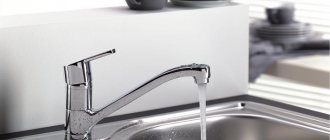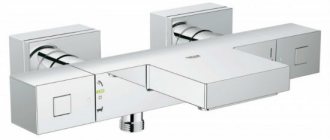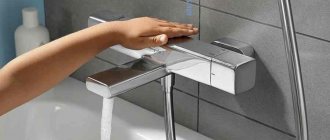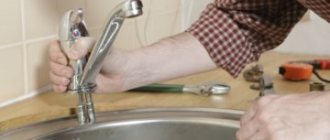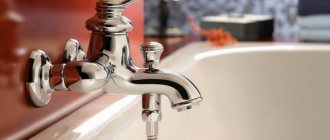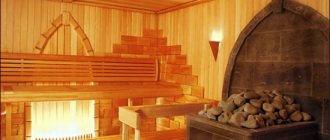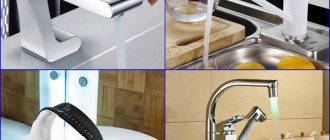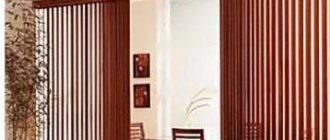VALVE MIXER
It is equipped with two types of crane boxes:
1. Crane axle box with ceramic plates.
2. Crane axle box on rubber gaskets.
FEATURES OF THE FIRST TYPE OF PRODUCT
— The throughput capacity of the crane axlebox reaches 25 liters per minute.
— The ceramic crane axle box is easy to use. It opens and closes the water quickly, but is less resistant to impurities in the water.
— Rust, scale, small stones wear out the ceramic plates and disable the valve axle.
— The ceramic faucet axlebox opens the passage hole, especially for faucet axleboxes with dimensions ⅜. This significantly affects water savings, but greatly reduces the flow rate of water from the faucet.
FEATURES OF THE SECOND TYPE OF PRODUCT
— The rubber valve axle box opens the passage opening one hundred percent and makes it much smoother. This makes it more convenient and accurate to set the desired temperature.
— The rubber gasket of the axlebox valve, which locks the water, is less sensitive to dirt, sand and rust. However, the rubber gasket wears out under the influence of different temperatures.
— Opening and closing the valve box is accompanied by loud noise.
— Over time, the rubber valve axlebox becomes difficult to close. This is due to the fact that the brass rod at a temperature of 85˚C becomes overgrown with a layer of brass oxide and increases in diameter.
Despite all this, valve mixers are the most economical option, having a high degree of maintainability. And it is quite possible to replace the faucet axle box on such a mixer yourself, without the involvement of a specialist, which is a colossal advantage.
Variety of design solutions
The key parameter for choosing a mixer is the design and principle of operation. The type of water mixing partly determines the cost, convenience and reliability of the device. Its practicality lies in the speed of on/off, the ease of adjusting the pressure and temperature of the water, as well as the ability to replace broken parts.
Two-valve mixer - a classic of the genre
The traditional design with two side valves is still in demand. The water supply is adjusted using a pair of flywheels - axle-box taps.
The hot stream is mixed with the cold stream in the housing and a warm stream is supplied out through the gander. There is a filter mesh at the end of the spout to prevent splashing of water.
Device diagram: 1 – body with three socket holes, 2 – spout, 3 – faucet axle boxes, 4 – decorative handwheels, 5 – screws for fixing the wings, 6 – protective caps
Two types of valve axle boxes are used in two-valve faucets:
- Worm-type locking elements . The rotation of the flywheel causes the piston to act on the rubber gasket, which locks or opens the hole. The rubber or silicone liner wears out over time and must be replaced.
- Ceramic crane axle boxes . The basis of the locking element is ceramic plate with holes for water supply. When the tap is turned, the plate unfolds and the hole aligns with the “water” channel. The larger the lumen area, the greater the volume of water supplied.
In ceramic models, the rotation of the flywheel is limited. The maximum rotation angle is 90-180°, which is significantly less than in mixers with a worm-type modification of the faucet axle.
Designations in the figure: 1 – worm-type valve-axlebox, 2 – half-turn valve with ceramic fittings. The main advantages of a two-valve mixer: housing strength, interchangeability of parts and affordable cost
The main advantages of a two-valve mixer: strength of the body, interchangeability of parts and affordable cost. Their weaknesses are the need to insist on temperature conditions each time, and more frequent failures compared to other products.
Ease of use of a single-lever device
Single-grip models are in high demand due to their ease of control - the intensity of the water flow and temperature are regulated by moving a single lever in two multidirectional planes.
A special feature of the internal mechanism is the presence of two spherical surfaces. Combining them allows you to regulate water flow indicators: vertical movement - pressure, horizontal movement - temperature
There are two types of switching mechanisms:
- disk (rod);
- ball
Disc cartridge . Replaceable mechanism with rotating ceramic discs. The work is based on the mutual movement of ceramic plates with cutouts. Depending on the number of plates, two- and three-disc cartridges are distinguished.
In a double-disc mixer, the upper plate is fixed to the control rod, the lower plate is rigidly fixed in the cartridge body.
By turning the handle, the discs move, the holes completely or partially coincide - the liquid is mixed. The pressure is adjusted by moving the upper element
In three-disc cartridges, the middle plate is movable. The taps are suitable for low pressure water supply systems. The water is mixed in the valve body, and not between the plates, due to which the resistance inside the mixer is reduced.
Advantages of taps with disc cartridges:
- maintainability - to restore functionality, it is enough to replace the internal mechanism;
- the increase in the cold water channel is proportional to the decrease in the flow of hot water - this ensures efficient use of water resources;
- ease of control.
The disadvantage of a ceramic cartridge is its vulnerability to hard, contaminated water. To use them, it is advisable to install a prefilter.
Ball mechanism . The regulator is made in the form of a hollow metal ball. There are three openings inside: two are side channels for water supply, one is for the mixed flow outlet.
Depending on the position of the lever in the horizontal plane, the gap for water to enter the mixing chamber changes. The necessary sealing is provided by spring-loaded fluoroplastic inserts
Since the mixing of water flows occurs inside a metal ball, scale forms on it - one of the reasons for the breakdown of the mixer.
We also recommend reading the article in which we described in detail the most common causes of breakdowns of ball mixers and how to fix them. Read on for more details.
Additional disadvantages of the spherical mechanism:
- low maintainability;
- rapid wear of seals.
Such a device is resistant to pressure changes, water hammer, and is also less demanding on the quality of tap water.
You can read more about single-lever faucet models in this material.
Safety of using the thermostat
Devices with a thermostat ensure stability of the supplied water temperature. Outwardly, they resemble a traditional model - the body is equipped with two adjustment handles, an inlet and a spout. All technical differences are hidden inside.
Thermostatic product design: 1 – water pressure control head, 2 – temperature setting lock, 3 – temperature regulator, 4 – ceramic cartridge, 5 – “smart” mechanism – thermostat
The heart of the mixer is a heat-sensitive element, which, under the influence of temperature, changes its size and regulates the volume of hot mixture. It is enough to configure the necessary parameters once, and subsequent adjustments are taken over by the thermostat.
Advantages of thermal mixers:
- safe operation - eliminates the risk of burns with hot water;
- ergonomic modern design;
- temperature stability and ease of use;
- reducing water consumption that could have been wasted on manual adjustments.
There are a number of things to consider before choosing a thermostatic bathroom sink faucet. Firstly, the blocker stops the water supply if the temperature does not match the set value. In a house with a central water supply, where temperature fluctuations are frequent, you may not receive water at all.
Secondly, in systems with pressure surges, situations are possible when warm water is supplied from a “cold” pipe. The thermostatic mixer shuts off the hot water to reduce the temperature, but the user receives weak pressure at the outlet.
Mixers use two thermostat options: mechanical and electronic.
The mechanics are reliable and easier to “adjust” to the instability of the central highway. Electronic models have an informative display and different types of control: push-button, touch or remote
Mixer-doser – short-term water supply
Portion cutters, which are most in demand in public bathrooms, have also found their way into everyday life. The design of the mixer includes a water start button, a temperature regulator and a gander. When you press the key for some time, a portion of water is supplied.
The role of the locking element is played by a gasket placed on the extension of the rod. The components are placed in a special chamber - already mixed warm water enters this glass. The supply temperature is controlled by a side lever.
The batch mixer is installed in water pipes with a back pressure valve for hot/cold water. Otherwise, hot water in the mixing chamber will displace cold water
Using the valves will allow you to select the optimal position of the adjustable lever once and set a comfortable temperature.
The advantages of the mixer-dispenser are obvious:
- automatic shutdown;
- saving water temperature settings;
- Easy to use – just a light touch on the button.
Portion cutlery has a narrow purpose: hand washing, washing, light rinsing. The mixer is not suitable if using the sink involves a long supply of water and fine-tuning the temperature.
Features of electronic models
High-tech faucets are equipped with electronic components that are responsible for the accuracy of temperature heating and water pressure. Built-in sensors transmit a signal to the shut-off valve.
The functionality and configuration of plumbing systems is varied. Some devices contain a microprocessor that allows you to set the time and temperature mode of the mixer, turn on decorative effects, etc.
Based on the control method, a distinction is made between contact and non-contact electronic products.
Contact mixers . Touch control is provided - a display with an indication of current parameters and a settings panel is built into the molded case.
The mixer is started and turned off by touching the display, device body or spout. Electronic contact devices are sold as separate products or supplied complete with plumbing fixtures
Non-contact devices . Controlled by motion sensors and infrared sensors that respond to thermal energy. If you bring a heat source, in particular your palms, under the spout, the sensor will trigger and water will flow.
Popular electronic faucets are models with a photosensor. Automation reacts to the appearance of objects within a certain range of the built-in sensor
Advantages of electronics for the sink:
- advanced functionality;
- ease of use;
- modern design and decorative effects.
The main disadvantages of innovative plumbing: the high cost of the equipment itself, the complexity of repairs.
SINGLE LEVER MIXER
It is equipped with cartridges of various heights and diameters.
The most popular cartridge sizes:
— 25 mm, throughput up to 12 liters per minute.
— 35 mm, throughput up to 22 liters per minute.
— 40 mm, throughput up to 25 liters per minute.
The diameter of the cartridge directly determines how quickly you fill the bathtub and the pressure with which you will take a shower.
The main advantage of single-lever mixers is quick and convenient operation. We open, mix and close the mixer in one motion. This happens much faster than with a valve one. And saving time, even 3-4 seconds, entails huge savings in water.
The disadvantages of single-lever mixers are their low maintainability and difficulty in finding and selecting cartridges. An important condition for the comfortable use of a single-lever mixer is the presence of a low amplitude of the pressure difference between cold and hot water (the amplitude should not exceed 10%). With a higher value of this indicator, it will be difficult for you and me, as consumers, to adjust the water to the desired temperature, and we will spend a significant period of time on this.
Faucets with sensor
These products are also called contactless. They do not need to be turned on manually, as they are equipped with an infrared-type motion sensor. As soon as you put your hands to the tap, water starts pouring out of it. The sensor coverage area can be adjusted. The temperature is adjusted using a small lever.
+ Pros:
- Hygienic - no direct contact of the surface with dirty hands. This is convenient for public bathrooms.
- Easy to use - no effort required.
- Minuses:
- Price level.
THERMOSTATIC MIXER
A more modern and more sophisticated look. The main principle of operation of a thermostatic mixer is to maintain a constant temperature of the mixed water flow, regardless of pressure drops in the general water supply mixer.
The main unit of a thermostatic mixer is a thermostatic cartridge, the heart of which is an expanding material consisting of several types of wax and other components. As the temperature rises, the waxy contents expand and press on the diaphragm. The support spring ensures that the diaphragm returns in the opposite direction when the water temperature drops. The thermostat response speed ranges from 0.3 to 3 seconds.
The mixer independently mixes cold or hot water depending on which direction the pressure drop in the water supply system occurs. As a result, you and I get an even, stable, comfortable water temperature.
In most cases, the pressure drop of cold or hot water is that all consumer elements - faucets, toilet, washing machine and dishwasher, if any, are powered in series on the water supply line. As a result, opening or closing water at any consumption site affects the entire system as a whole.
A simple example: a person takes a shower. It adjusts the water to the required temperature and pressure. At this time, at another consumption site, a person turns on the kitchen faucet. And, naturally, a pressure drop occurs, which affects all settings of the first consumer.
The undoubted advantage of this type of mixer is the enormous water savings, since there is no time to manually adjust the temperature and water strength.
The disadvantages of this type of mixer are the impossibility of repair without the involvement of a specialist and the rather high cost.
Mixer thermostats
Equipped with two handles with safety locks, they allow you to quickly vary the temperature (regulated by the first valve) and pressure (regulated by the second valve). Limit buttons on the handles make it possible to set the parameters that are needed. The next time we turn on the tap, we will get water with the desired temperature and pressure.
+ Pros:
- Saves water, makes adjustments as fast as possible.
- Possibility to set the desired parameters. This is convenient, for example, when bathing a child.
- Modern elegant design.
- Minuses:
- High price.
TOUCH MIXER
The most innovative faucet operating principle, based on electronic elements with an infrared sensor. The intended purpose of this type is public places with a large flow of people. This product is designed to maximize water savings. The touch mixer operates on batteries, accumulators and from the mains via a 12 volt power supply. This was done for human safety. The power supply usually comes with the device. The main condition for using a sensor mixer is uninterrupted power supply, since without this condition it will not work.
We have analyzed mixers based on the principle of their operation, now let's look at the classification of mixers based on the principle of their intended use.
Shower faucets
Based on the type of design, shower faucets are classified in the same way as other faucets, that is, single-lever, double-valve, etc. A characteristic difference is the absence of spout.
There are two types of shower fixtures on the market today:
- wall-mounted mixer;
- built-in
The first type of faucet is wall mounted. Wall-mounted mixer taps may include a wall-mounted or floor-mounted shower stand. The stand makes it possible to adjust the height of the shower head.
Expensive shower models are equipped with built-in mixer taps. The advantage of this equipment is ergonomics and attractive appearance.
All working components of the mixer are hidden from view, mounted into the wall and covered with a panel. Only the control system is located on the front side of the shower stall.
According to the method of adjusting the pressure and heating of water, there are:
- mechanical;
- electrical;
- thermostatic.
Design of a mixer for a shower stall The device consists of two units:
- the first node is a block for mixing hot and cold water, regulates the temperature and inclusion of water;
- the second is the switching socket. It is a cartridge with one input and several outputs. The switch socket receives the water prepared by the mixing unit and directs it to the specified outlet.
Classification of mixers by number of modes The plumbing market offers devices with switching modes from one to seven. One position is the simplest option; the mixer can only operate in one mode – “shower” or “hand shower”.
Two modes – provides the ability to switch from an overhead shower to a hand shower. Three positions – works in the “top shower-head shower - tropical shower” modes. The most common model of shower mixer has a hydromassage function in the lumbar region.
Four positions - has the same modes as the mixer with three positions, added with the function - foot hydromassage.
Five or more modes are expensive models that are not very popular among consumers due to their high cost.
BATHROOM MIXER
This type of mixer is multifunctional. With its help, we can fill the bathtub, collect water in various containers - buckets, basins, vases. Using a diverter switch, redirect the flow of water from the spout to the shower head through the shower hose in order to take a shower.
Bath faucets are divided into two types:
1. With a long swivel spout, sizes 250-400 mm
2. With a short, most often fixed, spout, dimensions 150-170 mm.
There are three types of spouts:
1. Flat.
2. Round.
3. Curved.
If flat and round spouts are made by the manufacturer for design variety, then the curved one performs a technical function: when turning from the bathtub to the sink, it provides a higher distance between the spout and the washbasin for comfortable use.
Almost each of them is equipped with an aerator.
An aerator is a device designed to saturate the water flow with air; it breaks up air pockets.
Some aerators are capable of changing the angle of water supply pressure. Thus, you and I get a soft, pleasant flow.
Bath faucets are equipped with various types of diverters - switches.
A diverter is a device that switches the flow of water from the spout to the shower head through the shower hose, and in the opposite direction. The diverter can be built into the mixer body or attached to it as a separate part.
Switches - diverters can be divided into several categories:
— PUSH-BUTTON
With or without a lock. It operates on the basis of a return spring. It should be noted that mixers equipped with this type of diverter last a long time and have virtually no complaints. The difficulty that arises when operating this type without a lock is that with low pressure in the water supply system, this diverter is not able to maintain the flow of water to the watering can through the shower hose, returning it to its original position on the spout.
— BALL
It is the simplest and most reliable switch. The design is based on a ball with a hole, which is located on sealing rings. Using the handle, we turn the ball and direct the flow of water either to the spout or to the watering can through the shower hose. This switch is by far the most popular type of diverter among buyers.
This type has two operating principles:
1. Based on the crank rod, with the help of which a brass bushing with rubber cuffs shuts off the water, directing it in the desired direction.
2. Based on special mini-cartridges and specialized faucet boxes made of ceramic plates.
— INTUITIVE
It is integrated into the water flow handle or into the swivel faucet spout. The operation of this type of switch is based on a three-way valve.
The principle of operation is as follows: the water flow handle is in the middle position, the “everything is off” mode. We begin to turn the handle towards ourselves, and the water is supplied to the spout. To switch water to the watering can through the shower hose, you need to start turning the water flow handle away from you, switch to the “everything is off” mode, after which the water supply to the shower hose will turn on.
The operating principle of the switch integrated into the swivel spout is quite simple. We turn the spout towards ourselves and the water supply to the spout is turned on. We begin to turn the spout away from us - the water supply to the shower head is turned on.
You should also pay attention to the configuration of bathroom faucets. Almost every kit includes:
1. Shower hose measuring 1.5 meters.
2. Watering can holder.
3. Shower head (single-function or multi-function).
4. Reflectors for the mixer, hiding the connections and giving the product an aesthetic appearance.
5. Eccentrics for installation - eliminate errors when installing the product.
Two-valve mixer.
These mixers have been known since Soviet times. However, even now they have not lost their relevance. Two-valve faucets are successfully used for both kitchen sinks and bathrooms. The bathroom uses a faucet with a shower diverter. A two-valve mixer looks like a faucet with two valves. It will take more time to adjust the water temperature than with a single-lever mixer, but the result will be more accurate. Thanks to this, water is consumed more economically, which is important if the apartment has a water flow meter. In two-valve faucets, rubber gaskets or ceramic discs are used as a closing element. Rubber gaskets are adapted to low water quality, they are easy to replace and are cheap. But their service life is short. Ceramic discs last a long time and to adjust the water, just turn the valve half a turn, which is convenient to use.
KITCHEN FAUCET
Designed for kitchen sinks. Kitchen faucets are divided into products with high and low spouts.
The horizontal length of the spout from the base for both types of faucets is 22-25 cm. This size standard is determined by the size of the kitchen sink, which is 40-45 cm in diameter. Kitchen faucets are designed to deliver water to the center of the sink. Also, both types of faucets have a freely rotating spout.
Kitchen faucets come with pull-out spouts.
The extension length of the watering can reaches from 20 to 150 cm. Water is supplied to them either through a central aerator or through a sprayer, as in a shower head. Using such a mixer, you can draw water not only into large-volume pots, but also into containers located outside the boundaries of the kitchen sink.
The kitchen faucet with a flexible spout, the length of which reaches 60 cm, has the most unusual design. The design of this spout is a flexible but rigid hose. With the help of your hands you can give it the necessary shape and direction. With the help of such a faucet, you can collect water in large containers, even if your kitchen sink is shallow.
There is also a type of modern kitchen faucets that can connect to the filtration and purification system of tap water and supply purified water. This type of mixer has two control handles:
1. Right handle - responsible for supplying regular tap water.
2. Left handle - works like a valve (opens and closes purified water supplied from the mixer).
It should be noted that in this mixer, ordinary and purified water never mix, as they pass through the spout in different channels.
You should also pay attention to the configuration of the kitchen faucet. The kit includes:
— Flexible eyeliner, sizes from 20 to 40 cm.
— Kit for attaching to the sink.
Differences in faucets by spout type
Short spout
A small spout (15 to 18 centimeters) can be suitable for both a compact bathroom sink and a bath-shower mixer.
Long spout
The size of this product is 20 centimeters or more. It can be useful in the kitchen, as it gives you more space to wash your hands or dishes. A spout of more than 30 centimeters is needed if there is one common faucet for the sink and bathtub.
Flexible spout
Also relevant for kitchen conditions. Outwardly, he is no different from his brothers. But if you pull its end, you can pull out a flexible hose up to 70 centimeters long. It helps to wash the sink, dishes, vegetables and fruits.
Kitchen faucet with flexible pull-out spout.
WASHBASIN MIXER
Simple, constructive look. The main criterion for distinguishing this type of faucet, in addition to design, is its size and spout length.
Small sink faucets are used for small washbasins. Accordingly, washbasin faucets with a larger height and spout length are designed for large sinks.
Some nuances
As a rule, the falling stream does not exit the mixer at a right angle, which is known to be 90 degrees. Of course, except for those cases when this angle is provided by the design of the “gander” of the mixer. The angle of incidence of water is always 20-45 degrees greater than the direct one. This angle must be taken into account when calculating the length of the spout. It is also necessary to take into account the distance from the installation site of the mixer to the side of the sink. There are models of mixers where, due to their design features, water comes out at a fairly large angle, significantly different from a straight one. For such devices, a large-width sink is required, otherwise all the walls will be flooded, and it will be impossible to use the plumbing to its full potential.
BIDET MIXER
Its design is very similar to a washbasin faucet. The difference between a specialized mixer is that it has a freely rotating aerator that can direct the flow of water in the desired direction.
We also need to consider issues related to all mixers, regardless of the principle of operation and the type of their intended use.
This:
— Design of mixers.
- The materials from which they are made.
- Their coverage.
— Manufacturers' warranty.
Selecting the right mixer
The faucet used in conjunction with the sink has, among others, such parameters as the length and height of the spout. They will be the main ones in the selection process and you need to focus on them. Typically, up to fifteen centimeters, this is a low spout; a high spout reaches a quarter of a meter. It is clear that the middle spout occupies an intermediate position. do, The tall mixer allows you to perform many different actions? The height of the device, reaching 30 cm and above, is needed for such operations as washing the bottom of a small child, washing a dog’s paws, or getting rid of dirt on shoes. With this mixer level you can even wash your hair in peace. If the mixer is installed on the wall, then it is important to first estimate at what angle the stream falls. This parameter will influence where and at what height the faucet will need to be installed relative to the sink.
Devices with a rotary aerator manufactured by Kludi are quite popular. They can vary the angle of the water jet with just a slight touch of a finger. Therefore, it is necessary to provide for all options for the fall of the stream and choose a sink that will absorb water even after an accidental incorrect press. Ideally, the stream should always hit the bottom of the sink. By the way, the Kludi company produces mixers with variable height. They can be precisely adjusted to fit your existing sink.
DESIGN
Currently, end consumers place demands on faucets not only as a sanitary product with practical and functional properties, but also as an integral design element. Therefore, faucets for bathtub, kitchen, washbasin, bidet and shower are made in series so that the consumer can maintain a single style when carrying out renovation work. The specialists responsible for developing the design of faucets are not inferior in dynamics to designers designing the renovation of an apartment or house.
How to choose products by design?
It is clear that the most effective way is to buy these plumbing elements from one collection. In this case, both the faucet and the sink will perfectly complement each other, both in terms of operational parameters and style. By the way, serious manufacturers always indicate various installation methods in the product documentation.
If you can’t choose a sink and a faucet from the same collection, then you need to follow some of the designers’ recommendations. The geometric shapes of the faucet and sink should resemble each other. A round faucet should be combined with a round sink and vice versa. Combining retro and modern is also not recommended.
Similar articles:
- How to Choose Burlington Bathtub and Sink Faucets
- Black and white bathroom - what's inside.
- 11 simple tips to turn a small bathroom into a big one
- Beautiful traditional bathroom with Burlington fixtures
WARRANTY TERMS
The manufacturer's guarantee is that the product will operate for a certain period of time without breakdowns, subject to certain storage conditions, operating and installation rules.
The manufacturer undertakes to eliminate manufacturing defects that arose during the warranty period or to completely replace the product.
The decision to replace the product or eliminate defects is made by the service center. The warranty does not cover acquired defects or defects resulting from improper use and installation of the products.
Let's consider the standard requirements for operation and installation of the product:
1. Hot water connection on the left.
2. The pressure difference between hot and cold water should not exceed 10%.
3. The hot water temperature does not exceed 65 degrees.
4. The presence of a mechanical filter and a mesh not exceeding 100 microns in size.
5. Do not use detergents containing alkali, acid, acetone or abrasives.
It would seem that what is so difficult here? Turn the tap in one direction - water comes out, turn it back - no water comes out. It turns out that not everything is so simple. Now we know the mechanism of how mixers work from the inside and, therefore, we understand how this wonderful device makes our life easier.
According to manufacturing materials
The following materials are used to produce bathroom sink faucets.
Aluminum alloys
One of the alloys used for the production of taps is silumin with 4–22% silicon content. This alloy has good corrosion resistance, but is brittle, which increases with increasing silicon content. Another disadvantage of silumin is high porosity with a coarse-grained structure of castings, which negatively affects the mechanical strength of products.
Cheap Chinese-made faucets are most often made from silumin, which are attractive in appearance, but very short-lived. The alloy is coated on top with chrome plating, enamel or special paint to give it solidity.
Silumin taps are attractive, but unreliable.
The main failures are associated with the fragility of the material - when you try to tighten the nuts, they simply break off or crumble.
Due to their fragility, parts made of sanitary silumin often fall apart when trying to tighten a leaking connection.
Stainless steel
Stainless steel taps are resistant to corrosion and have a long service life (provided that high-quality steel is used). Such plumbing devices belong to the middle class, and their price corresponds to the quality.
The faucet is made of high quality stainless steel and can last for more than ten years.
Copper alloys
The most popular are faucets made of copper or copper-based alloys. Since copper taps are very expensive, brass or bronze are most often used. Such cranes are characterized by high performance characteristics: durability, reliability and wear resistance. In addition, copper-based alloys are not subject to corrosion and have good resistance to the formation of hard deposits on the walls.
Faucets made of copper, bronze or brass are often made in fancy shapes or designed to look antique. For such devices, the metal is not coated with anything, but is embossed or engraved to give it an entourage.
Note! Brass taps, made in a modern style, are coated with chrome, so they differ little from products made from other materials. To make sure that the faucet is brass, you need to inspect the lower part where the holes for connecting the flexible line are located. The fastening unit should have a slightly yellowish tint.
The yellowish tint at the bottom of the faucet indicates that it is made of brass.
Ceramics
An original solution is to install a faucet made of reinforced porcelain. This plastic material allows the production of plumbing products of various shapes and configurations. Such cranes are reliable, durable, and have an interesting and attractive appearance. The disadvantages of ceramic products include their high cost and the need to be careful during operation so as not to damage the faucet.
Porcelain faucets have an interesting look and will fit into a bathroom decorated in any style.
Plastic
Plumbing fixtures are also made from modern polymers. Such faucets have different colors, and are also decorated with artificial stone or chrome plating. The advantages of plastic plumbing fixtures include their fairly low price and resistance to corrosion, while the disadvantages are their short service life and low resistance to shock and mechanical loads.
New on the plumbing market: a plastic faucet.
Note! Plastic plumbing products have not yet proven themselves to be reliable and durable equipment. But technologies are constantly being improved and, perhaps, in the future, they will provide worthy competition to brass models.
Design features
Unlike a kitchen faucet, a washbasin faucet is not equipped with a long spout. Depending on the design, models installed on the sink are divided into two types:
- Cast. Such devices have a monolithic body, which makes them more reliable, since the design is simplified and the number of moving parts is minimized. Most often, cast faucets are installed on a small sink, since they themselves are compact in size.
Cast faucet. - Rotary. Swivel type mixers have a jib that rotates in a horizontal plane. The prefabricated design of the body makes the faucet more functional, since the spout can be turned in the direction convenient for use.
Mixer tap with swivel spout.
Spout shape
In addition to standard and familiar shapes, spouts on some models can be original and unusual, for example, antique-style or made in the form of various shapes.
Oriental-style faucet spout in the shape of a dragon.
Modern cascade faucets do not have the usual spout or gander spout. In such devices, water is supplied to round plates or shelves of various shapes, from which it flows in the form of a waterfall. LED lighting is also used, which further expands the decorative capabilities of a conventional faucet, as shown in the photo below.
Examples of original design of a faucet spout in high-tech style.
Tips on how to choose a faucet for a bathroom with shower or kitchen
If hanging low shelves are installed above the sink or washbasin, then when purchasing a faucet you must take into account its maximum height - the distance from the base to the top point of the device. It should be less than the distance between the sink and the shelf. A spout that is too long or low is not suitable for compact, shallow sinks, and a faucet with a short gooseneck is inappropriate for a deep, large washbasin or a bathtub with wide sides (it simply may not “reach”). Modern designer faucet models include spouts of unusual shapes - flat, wide, bowl-shaped (they are also called cascade). So, in order not to get into trouble and not buy the wrong product, compare the width of your washbasin, for example, and the width of this very spout (it should not occupy more than half the width of the vessel). When purchasing a faucet with a shower head, it is worth considering the length of the hose, especially if you have a large bathroom or double kitchen sink.
Do not forget also about the type of fastening: if your sink has three holes and you do not plan to replace it, then the mixer will have to be selected to fit these holes, that is, with two valves. For a bathtub and washbasin located close to each other, you can install one faucet with a long “swivel” gander.
If you choose between a faucet with a lever or push-button mechanism for switching the water supply from the spout to the shower handle, then it is better to give preference to the lever. Practice shows that it is more reliable and convenient to use with “our” water.

